From the eastern coastal regions to the mountain foothills of the Upstate, South Carolina beckons us to go outdoors. Whether it’s a stroll on the beach or a hike through the woods, the Palmetto State is unmatched in its outdoor offerings for residents and visitors alike. But as we venture outside to enjoy everything South Carolina offers, we also need to be aware of hidden dangers. Some of the most poisonous plants in the United States can be found in places like South Carolina.
The toxicity of some of these plants can really ruin your day. Others could potentially threaten your life. We all need to recognize and steer clear of these six plants.
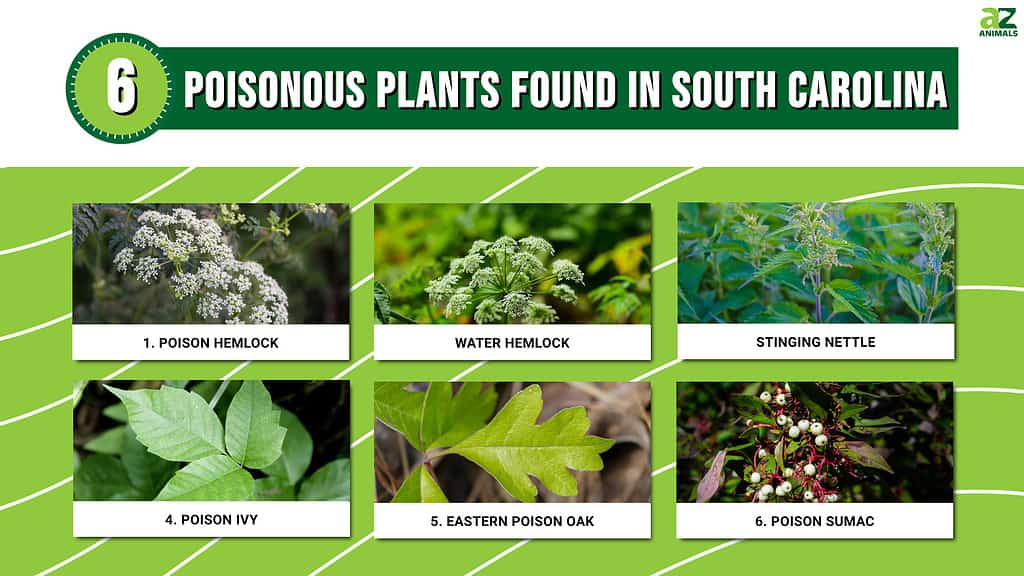
1. Poison Hemlock (Conium maculatum)
Poison hemlock is an invasive plant that was brought to the United States from Europe. It was originally distributed as an ornamental garden plant because of its white flowers, but the plant has since spread far beyond the reaches of domestic settings.
This highly poisonous plant is often found in South Carolina growing in ditches, along fence lines, and in other moisture-rich “ignored” areas. It usually begins growing in the spring and can grow for two years. In certain conditions, though, it can even take root as a perennial.
The plant can reach nearly 10 feet tall. It features white flowers that grow in small clusters. The flowers develop into fruit that turns grayish-brown at maturity. The roots of poison hemlock are easily mistaken for wild parsnips.

It is dangerous and can be deadly to ingest any part of poison hemlock, which blooms with small white flowers,
©iStock.com/gabrielabertolini
Every part of the plant is toxic (root, stem, leaves, and fruit). Poison hemlock contains coniine, g-coniceine, and related piperidine alkaloids, all of which are toxic compounds. Ingesting any part of the plant is dangerous, even deadly for humans. Children have died after making whistles from the hollow stems of the poison hemlock plant.
This plant has been infamous for centuries. It was widely circulated that Socrates ingested poison hemlock, leading to his death in 399 BC. That report is attributed to Plato, but its accuracy is debatable. Legend or not, the story reinforces the danger of this particular plant.
While ingesting the plant is highly toxic, simply touching it usually doesn’t cause a reaction (unlike poison ivy, for example). But if a person has a cut or other type of open wound, the toxins could possibly enter the bloodstream, making the person ill. Your best bet is to just steer clear of it altogether.
The plant is also toxic to pets and livestock. It is deadly for cattle, sheep, horses, and swine. Within 2-3 hours of ingesting hemlock, livestock can die from respiratory paralysis.
2. Water Hemlock (Cicuta maculata)
Water hemlock has earned the reputation as the deadliest plant in North America. It has an expansive range, growing in nearly every U.S. state, including South Carolina.
Like its relative, poison hemlock, it is most dangerous if ingested. Some claim it has medicinal purposes if applied to the skin. This, however, is quite dangerous, possibly even lethal.
Most accidental ingestion occurs through a case of mistaken identity. Many have mistaken water hemlock for edible plants such as artichokes, celery, sweet anise, or wild parsnips. The results are swift and devastating.
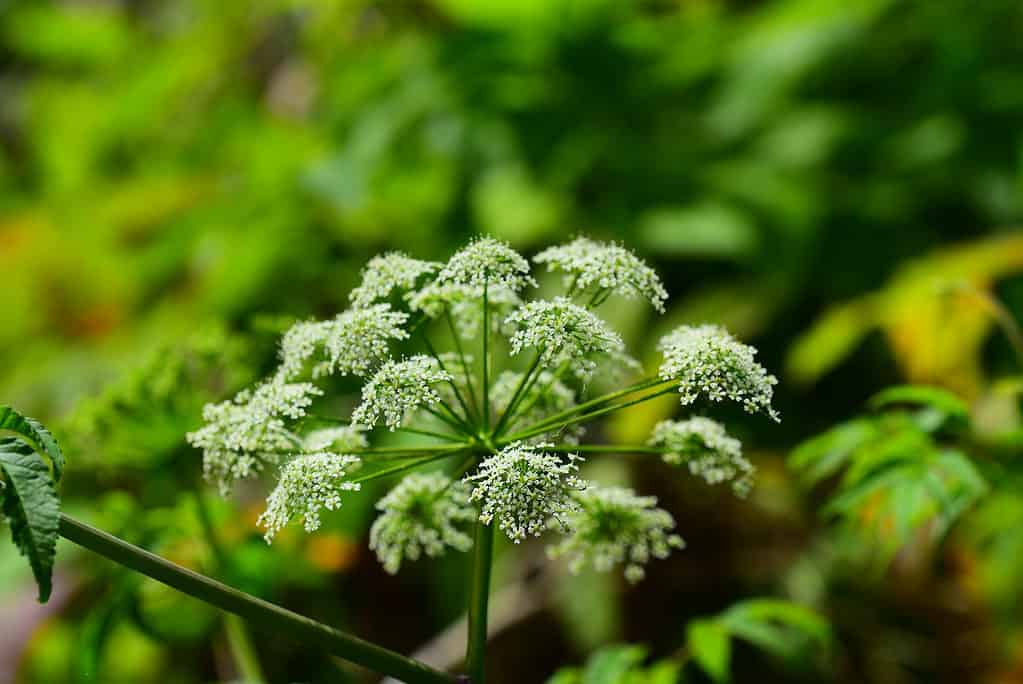
Ingesting water hemlock, or applying this plant topically to the skin, can have deadly consequences.
©iStock.com/cturtletrax
All parts of this plant are highly toxic to both people and animals. Ingesting the plant can cause abdominal pain, nausea, vomiting, delirium, and seizures. Symptoms can appear in as little as 15 minutes after ingestion and often lead to death.
As the name suggests, water hemlock usually grows in watery areas such as swamps and marshes, and along the banks of rivers, streams, and ponds. The plant can grow up to six feet tall and can feature a variety of color patterns. Purple and/or green with spots and stripes are common variations.
Ingesting, or even applying this plant topically to the skin, can have deadly consequences. Everyone needs to know this plant and stay away from it.
3. Stinging Nettle (Urtica dioica)
This invasive plant is native to Europe but has since naturalized throughout the United States and Canada. Also known as common nettle, the stinging nettle plant is an herbaceous perennial. This poisonous plant is often found in South Carolina beside streams and along trails. It also thrives on farmland, and anywhere else where the soil has been disturbed.
Nettles grow up to eight feet tall and have opposite leaves that are covered with stinging hairs called trichomes. The trichomes are hollow with needlelike tips. When touched, they inject histamines, formic acid, and other chemicals which result in stinging inflammation on the skin. In extreme cases, the toxins can cause an allergic reaction that can lead to hospitalization or, very rarely, death.

Stinging nettles are covered with hairs that release toxins when touched.
©iStock.com/Dmitri Zelenevski
Signs of a more severe reaction include trouble breathing, difficulty swallowing, nausea, vomiting, wheezing, and increased heart rate. If any of these symptoms are present, call 911 immediately.
Historically, and rather ironically, nettle was a food source for ancient cultures. It can still be eaten or brewed as tea today, but this should only be done by an expert. The plant must be cooked or dried to neutralize the toxins, which is not something to attempt without a very experienced practitioner to advise you.
Stinging nettle is also toxic to pets. Ingestion can result in profuse salvation, vomiting, labored breathing, and poor muscle control (ataxia).
Livestock can generally eat stinging nettle, but only after it has been dried. Never feed fresh nettle or add it to silage before drying.
Most animals will refuse to eat fresh nettle, but goats have a well-earned reputation for eating just about anything. While they can safely eat many invasive weeds and plants, fresh stinging nettle is toxic for goats.
4. Poison Ivy (Toxicodendron radicans)
This plant is almost ubiquitous in the U.S., growing in every state except California, Alaska, and Hawaii. It’s likely we all heard the same warning about poison ivy at some point in our lives: leaves of three, let it be! It’s sound advice, to be sure. But it’s also somewhat incomplete.
Poison ivy does have three leaves (except for a much rarer five-leafed variety), but it is a chameleon of sorts. It morphs and changes based on the setting, to the point where many cannot even identify the plant as poison ivy anymore.
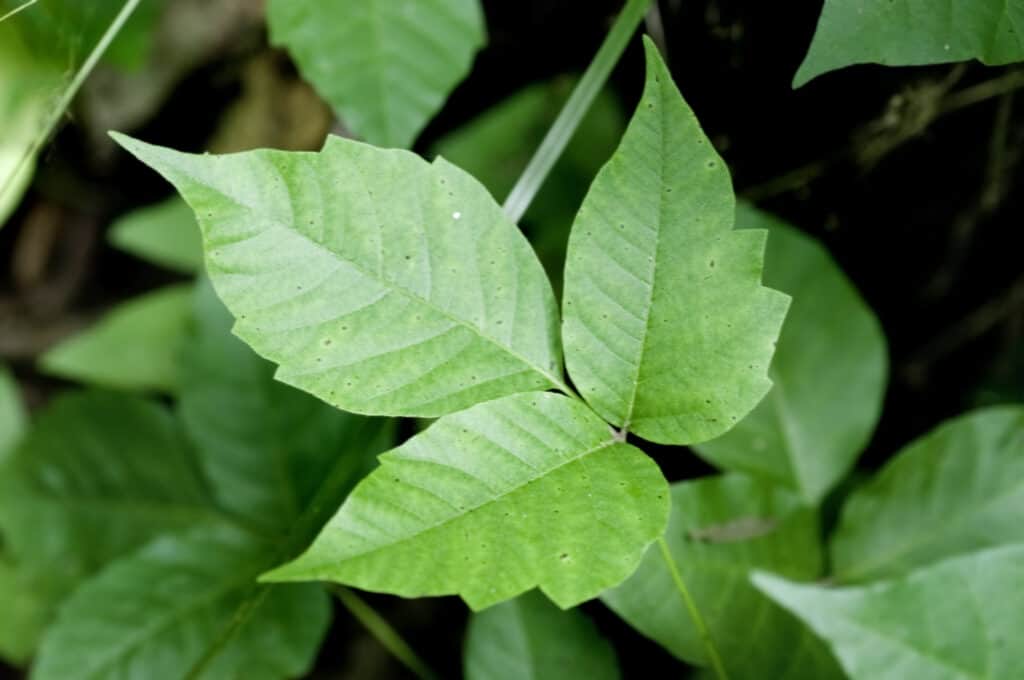
Poison ivy can be hard to identify as the leaves’ shape and size vary widely depending on the species.
©Tim Mainiero/Shutterstock.com
It can grow as ground cover, or it can grow into a woody vine that wraps around a tree, almost appearing to be part of the tree itself. The leaves of the plant don’t have a standard shape and size but can vary pretty widely depending on the species. This makes identification all the more difficult.
Poison ivy can grow virtually anywhere, but it specifically thrives in soil that has been disturbed. Construction, farming, tree removal, and landscaping all create conditions conducive to the proliferation of poison ivy.
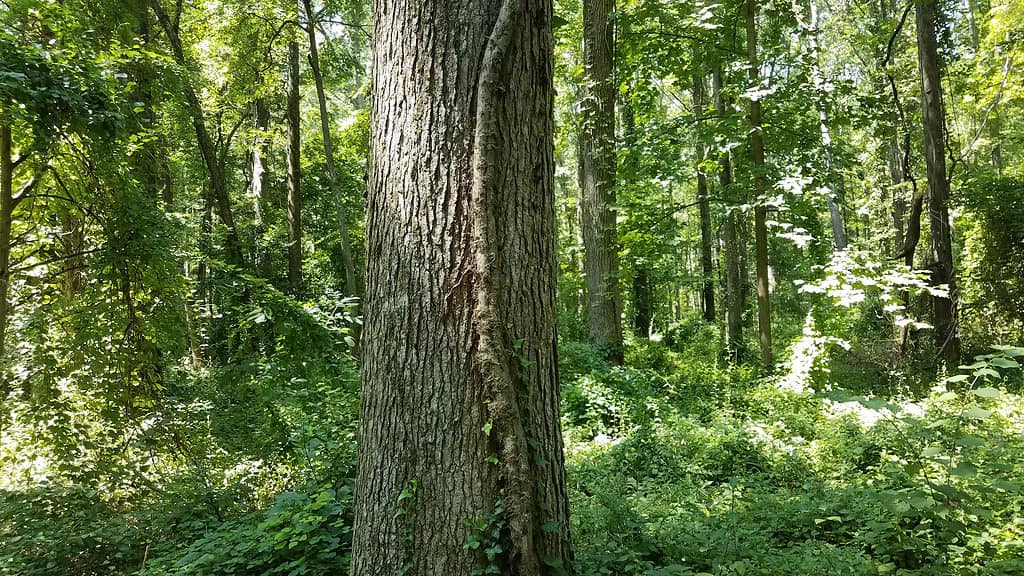
Poison ivy can grow virtually anywhere, including as a woody vine that wraps around a tree.
©iStock.com/Justin Smith
Toxicodendron in the plant’s botanical name translates as “poison tree.” Poison ivy is part of the same family as poison oak and poison sumac. Touching the plant can cause an irritating skin rash. In rarer cases, the rash can lead to more serious medical problems.
Urushiol, an oily resin in poison ivy’s leaves, is the culprit for the skin and mucous membrane irritation that occurs as a consequence of touching the plant. The rash typically appears 12-48 hours after exposure and can last from two to three weeks. It is estimated that 85% of people are allergic to urushiol. 10-15% are said to be highly allergic to the chemical.
Symptoms of a more serious allergic reaction requiring immediate medical attention include excessive swelling, a rash that affects the eyes, mouth, or genitals, oozing blisters, or a fever over 100°F. Inhaling smoke from burning poison ivy is also highly toxic and will likely require immediate medical attention, as well.
Poison ivy is mildly toxic to pets. Ingestion may cause gastrointestinal issues, but it usually does not lead to serious complications. If your dog or cat brushes up against the plant, their fur will likely protect their skin from irritation. They should still be bathed, though. The toxin can rub off of them and onto your skin. The same is true for poison oak and poison sumac.

Unfortunately, poison ivy isn’t always marked with a sign. Be cautious!
©iStock.com/HABesen
5. Eastern Poison Oak (Toxicodendron pubescens)
There are two species of poison oak in the United States. Western (sometimes called Pacific) poison oak (Toxicodendron diversilobum) is found from the Pacific northwest through California.
In the eastern U.S., including South Carolina, you will find Eastern (or Atlantic) poison oak (Toxicodendron pubescens). While not as common as poison ivy, it’s still a threat that hikers, gardeners, and anyone else who engages in outdoor activities need to know about.
Like poison ivy, poison oak contains the urushiol toxin. If a person comes in direct contact with the plant, painful skin irritation can result.
This shrub is native to the eastern and central United States. It usually grows in drier areas of forests or thickets.
Poison oak is not actually a member of the oak family, but the teethed leaves closely resemble those of an oak tree, which gave rise to the common name of the plant.
The toxicity and symptoms of exposure are similar to those of poison ivy.
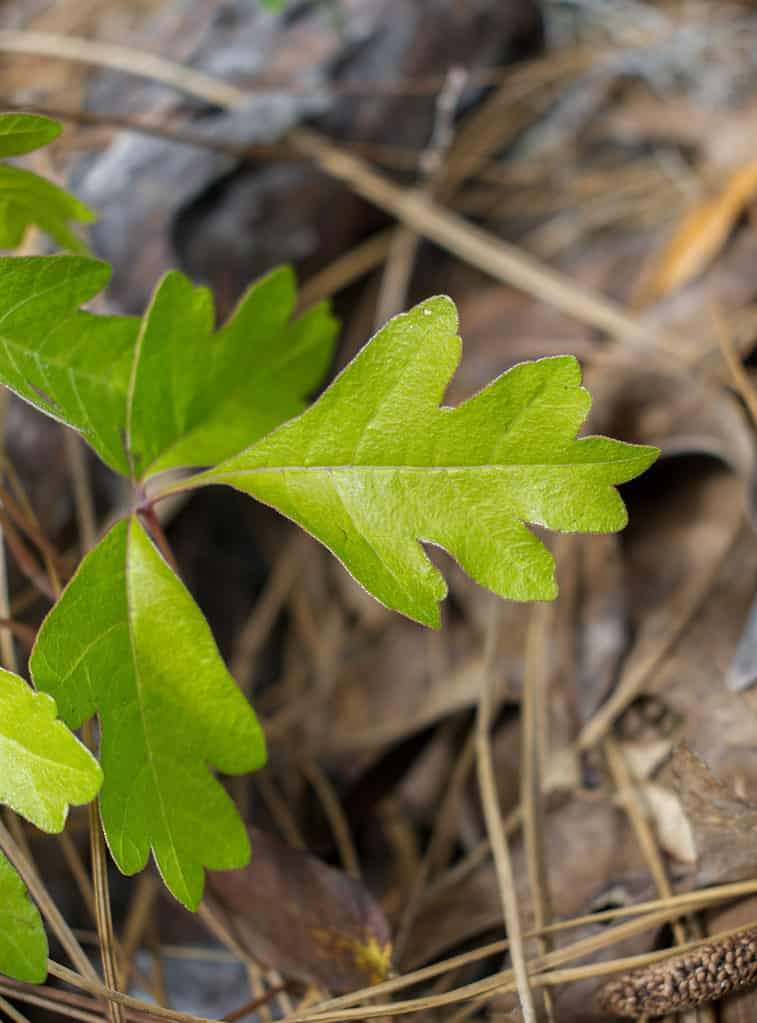
Eastern poison oak has leaves that look similar to those of an oak tree.
©iStock.com/Dan Rieck
6. Poison Sumac (Toxicodendron vernix)
The same urushiol toxin found in poison ivy and poison oak is also present in poison sumac but in a much higher concentration. The highly-concentrated toxin makes poison sumac even more dangerous. Every part of the plant contains this chemical. The urushiol can even remain active after the plant itself dies.
Poison sumac is a shrub or tree that can grow up to 20 feet tall. It is found primarily in wet areas such as marshes, bogs, and wet woodland areas.
Identifying poison sumac can be difficult because its appearance changes as the seasons change. The leaves can be dark green in the summer but turn a brilliant red or orange in the fall. Yellow-green flowers bloom in early summer and white berries appear in the early fall.
There is one telltale sign of a poison sumac plant that never changes, though. The stems of the plant are always red, making it much easier to distinguish from neighboring green-stemmed plants.
Touching the poison sumac plant results in similar symptoms as poison ivy and poison oak, but the severity is likely to be worse due to the higher concentration of the urushiol toxin. If symptoms persist or if they seem to be growing more severe, seek medical attention immediately.
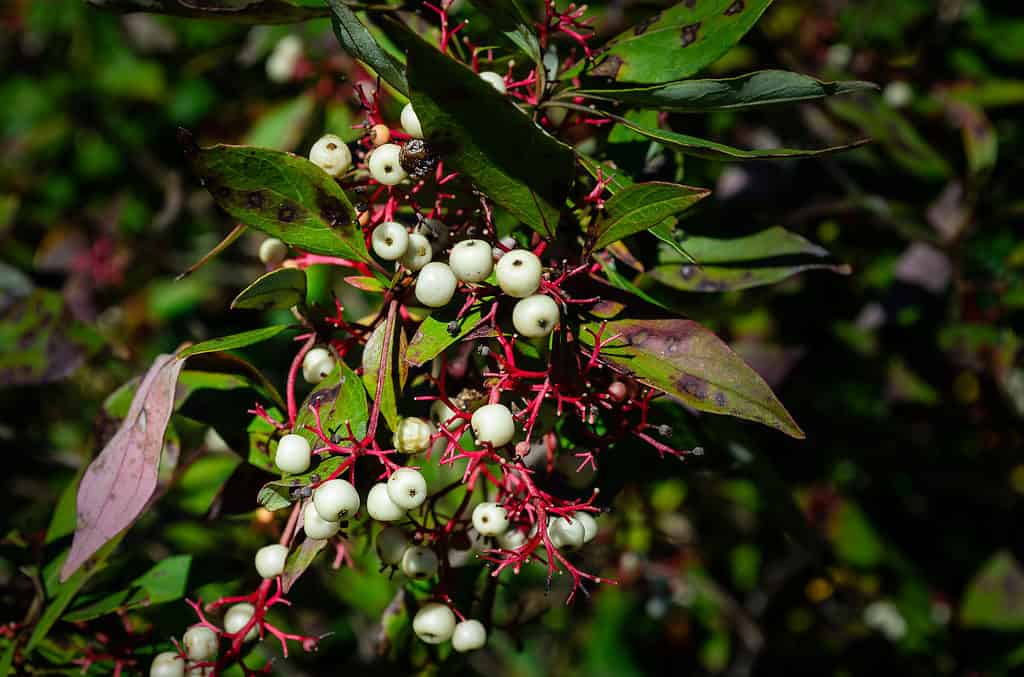
Poison sumac’s appearance may change with the seasons but it always has red stems.
©iStock.com/Grb
Summary of 6 Poisonous Plants Found in South Carolina
Here’s a recap of the six very dangerous plants we looked at that are present in South Carolina.
| Number | Plant | Toxicity | Location |
|---|---|---|---|
| 1 | Poison Hemlock | Ingesting any part of the plant is dangerous, even deadly for humans. It’s also toxic for pets and deadly for livestock. | In ditches, along fence lines, and moisture-rich “ignored” areas |
| 2 | Water Hemlock | All parts are highly toxic to people and animals. Symptoms can appear in 15 minutes after ingestion and often lead to death. | Watery areas such as swamps and marshes, and along banks of rivers, streams, and ponds |
| 3 | Stinging Nettle | When touched, it injects chemicals that result in stinging inflammation on the skin. An extreme allergic reaction can lead to hospitalization or, very rarely, death. It’s also toxic to pets. | Beside streams and along trails, farmland, and anywhere soil has been disturbed |
| 4 | Poison Ivy | Touching the plant can cause an irritating skin rash. In rarer cases, it can lead to more serious medical issues. It’s mildly toxic to pets. | Can grow virtually anywhere and thrives in soil that has been disturbed |
| 5 | Eastern Poison Oak | If a person comes in direct contact with the plant, painful skin irritation can result. Toxicity and symptoms of exposure are similar to those of poison ivy. | Drier areas of forests or thickets |
| 6 | Poison Sumac | The high concentration of urushiol toxin makes every part of the plant dangerous, so toxicity and symptoms are worse than poison ivy or poison oak. | Wet areas such as marshes, bogs, and wet woodland areas |
The photo featured at the top of this post is © iStock.com/email2ying
Thank you for reading! Have some feedback for us? Contact the AZ Animals editorial team.






